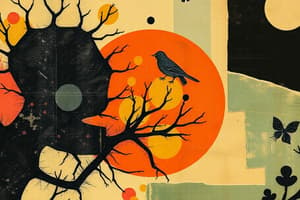Podcast
Questions and Answers
What is the role of producers in an ecosystem?
What is the role of producers in an ecosystem?
- They create their energy through photosynthesis (correct)
- They arrange organisms in a food chain
- They derive energy from other organisms
- They break down dead organic material
Which organisms break down dead organic material in an ecosystem?
Which organisms break down dead organic material in an ecosystem?
- Primary consumers
- Tertiary consumers
- Decomposers (correct)
- Producers
What do consumers do in an ecosystem?
What do consumers do in an ecosystem?
- Create their energy through photosynthesis
- Derive energy from other organisms (correct)
- Arrange organisms in a food chain
- Break down dead organic material
What are trophic levels in an ecosystem associated with?
What are trophic levels in an ecosystem associated with?
What is responsible for maintaining cellular integrity and selectively allowing molecules to enter or exit the cell?
What is responsible for maintaining cellular integrity and selectively allowing molecules to enter or exit the cell?
Which process allows cells to grow and replace damaged or dead cells?
Which process allows cells to grow and replace damaged or dead cells?
What did Robert Hooke's discovery of cells in 1665 lead to?
What did Robert Hooke's discovery of cells in 1665 lead to?
Which process involves replicating the cell's DNA, organelles, and other components before splitting into two daughter cells?
Which process involves replicating the cell's DNA, organelles, and other components before splitting into two daughter cells?
What can chronic stress and economic disparities lead to at a biological level?
What can chronic stress and economic disparities lead to at a biological level?
What are cycled through an ecosystem through processes like photosynthesis, decomposition, and nutrient exchange between organisms?
What are cycled through an ecosystem through processes like photosynthesis, decomposition, and nutrient exchange between organisms?
Study Notes
Exploring the Intricacies of Ecosystems in Biology
The realm of biology is vast and complex, encompassing various subtopics that reveal the intricate connections and interactions within living organisms. In this article, we'll explore the concept of ecosystems – ecological communities composed of diverse species interacting in a shared environment.
Ecosystems: A Brief Overview
Ecosystems can be found in varied environments, from rainforests to coral reefs, deserts to grasslands. An ecosystem consists of biotic components (living organisms) and abiotic components (non-living aspects of their environment). These elements are interconnected through energy and nutrient cycles, allowing the ecosystem to function and thrive.
Key Concepts in Ecosystems
-
Producers and Consumers: Producers (like plants and algae) create their energy through photosynthesis, converting sunlight into chemical energy in the form of glucose. Consumers, on the other hand, derive energy from other organisms, including other consumers and producers.
-
Trophic Levels: Organisms within an ecosystem are arranged in a food chain, with each organism serving a specific role, such as primary producers, primary consumers, secondary consumers, and tertiary consumers.
-
Decomposers: Decomposers (such as fungi and bacteria) break down dead organic material, recycling nutrients for reuse by the ecosystem.
-
Nutrient Cycling: Nutrients are cycled through an ecosystem through processes like photosynthesis, decomposition, and nutrient exchange between organisms.
Economic Inequality and Biological Harm
Though the biological topic of ecosystems appears separate from the economic concept mentioned in the introduction, there are connections between societal inequality and biological harm. Studies have shown that chronic stress and biological damage can be inflicted on individuals and societies due to economic disparities.
For instance, the stress caused by poverty and inequality can affect a person's biology, leading to chronic inflammation, chromosomal aging, and brain function impairment. These stressors can "get under the skin," influencing the biology of disease.
Biology of Cells: A Deeper Dive
Throughout the history of biology, the study of cells has been central to our understanding of living organisms. Robert Hooke's discovery of cells in 1665 has led to a rich and fascinating history of cell biology. In plants, cell biology has been instrumental in understanding various aspects of cell growth, division, and communication.
Cell Structure and Function
Cells are the fundamental units of life, providing the framework for diverse biological functions. For example, the cell membrane is responsible for maintaining cellular integrity and selectively allowing molecules to enter or exit the cell. The nucleus contains the genetic material (DNA) that governs the cell's activities.
Cell Division
Cell division (mitosis) allows cells to grow and replace damaged or dead cells. The process involves replicating the cell's DNA, organelles, and other components before splitting into two daughter cells.
Conclusion
Ecosystems and cell biology are fascinating subtopics of biology that demonstrate the interconnectedness and complexity of life. Understanding the relationships between living organisms, their environment, and cellular functions is critical to appreciating the rich and complex fabric of life on Earth. By exploring the intricacies of ecosystems and cell biology, we can gain a deeper understanding of the world around us.
Studying That Suits You
Use AI to generate personalized quizzes and flashcards to suit your learning preferences.
Description
Delve into the fascinating world of ecosystems and cell biology, exploring the interconnectedness of living organisms and their environments. The article provides insights into ecosystems, including key concepts like producers, consumers, trophic levels, decomposers, and nutrient cycling. Additionally, it delves into the intriguing realm of cell biology, examining cell structure, function, and division. Gain a deeper understanding of the complex fabric of life on Earth through the intricacies of ecosystems and cell biology.




